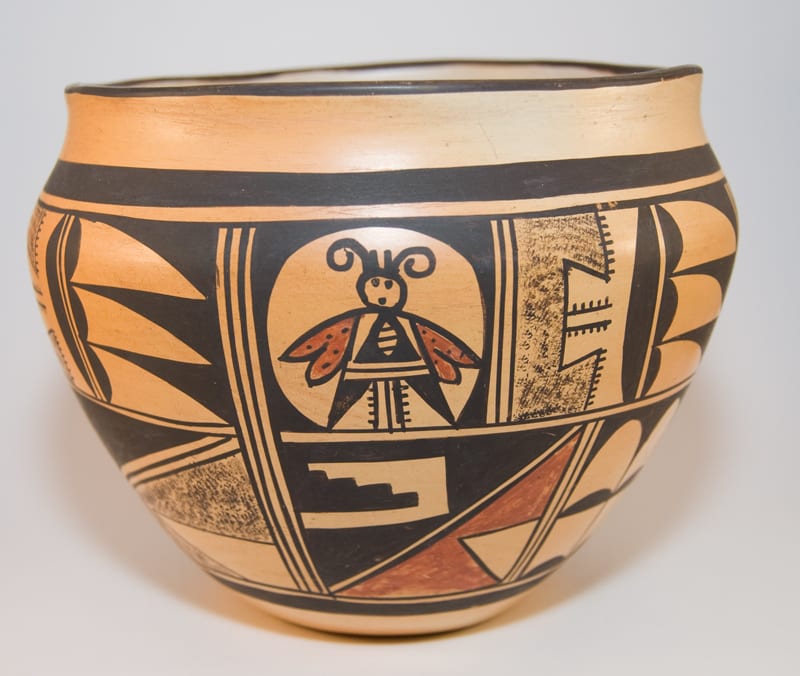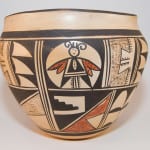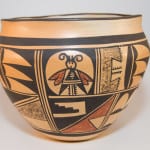The design on this polychromatic jar has traditional Hopi designs interspersed with four butterfly images. It is signed with the identification mark used by Hattie Carl.
According to Stanislawski (1976), “The motivation to mark pottery with a symbol or signature seems to stem from commerce with non-Indians. The use of an identification mark rather than a signature may have been due to unfamiliarity with English writing, or a wish to remain anonymous and seemingly less competitive.” This article notes that Hattie Carl was among the first four potters to use an identification mark (ca 1925-1930) and that “an undated pot with the cloud flower mark of Hattie Carl may be even older (1976:57, 51).” Although Hattie Carl apparently produced pottery from the early 1900s to 1951 (1976:65), the use of her mark on this jar dates it as circa 1925 to 1951.
We would know very little about Hattie Carl if it were not for a friendship and correspondence between Hattie’s sister and neighbor Ethel Muchvo and an Anglo tourist Maud Melville who, along with her family, visited Hopi in 1927. Ethel and Maud began a correspondence that lasted for ten years and is documented by Carolyn O. Davis in her book Hopi Summer (2007). The book makes incidental mention of Hattie Carl and reprints two photographs of her (2007: 133, 124).
Hattie was the older sister of Ethel; both were potters. Hattie married Edwin Carl, who had become a Christian and often interpreted services at The First Mesa Baptist Church, a missionary outreach to convert the “heathen.” After their marriage, Hattie also became Christian. Hopi life was very difficult during the 1930s and the letters from Hopi make it clear that Ethel and Hattie’s families were often close to starvation (Davis, 2007: 120, 141).
In 1936 and 1939, Hattie is reported to be making “some beautiful pottery.” Although she had no birth certificate, her family believes that Hattie was born in 1866; she died in 1970. (Davis, 2007:139, 141, 152-153). Thus, she would have been in her 40s when she began making pottery (after her children were grown) and in her 60s when she began using an identification mark on her pottery. Apparently, she made pottery until she was about 85 years old.
Stanislawski notes that in the mid-1970s, most First Mesa pottery was still unsigned, but that Hopi-Tewa potters (such as Hattie Carl) were three times more likely to sign their pots than were Hopi potters. Citing other sources, the article suggests that the greater use of identification marks on Hopi-Tewa pottery is due to their greater assimilation into Anglo culture (1976:55). Hattie Carl’s willingness to attend Christian services (which excluded her from the traditional religious activities of her village) lends credence to this hypothesis and may explain why she was among the first potters at First Mesa to sign her pots.






